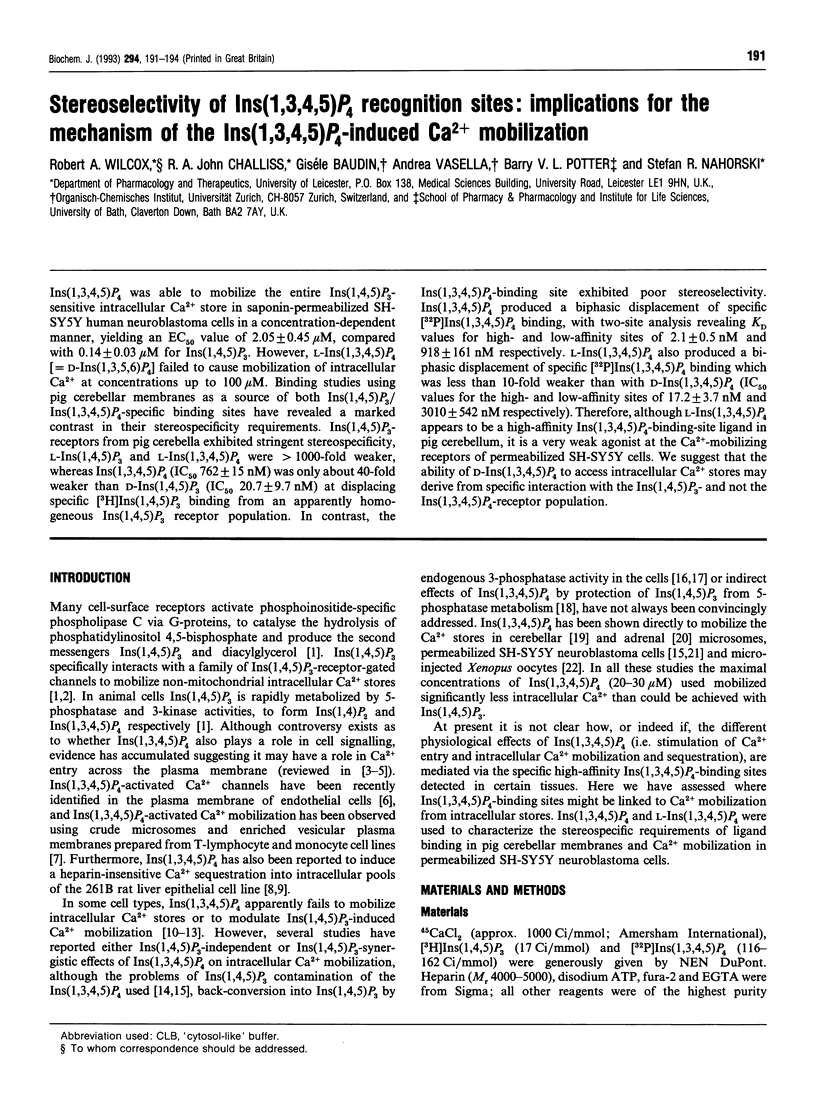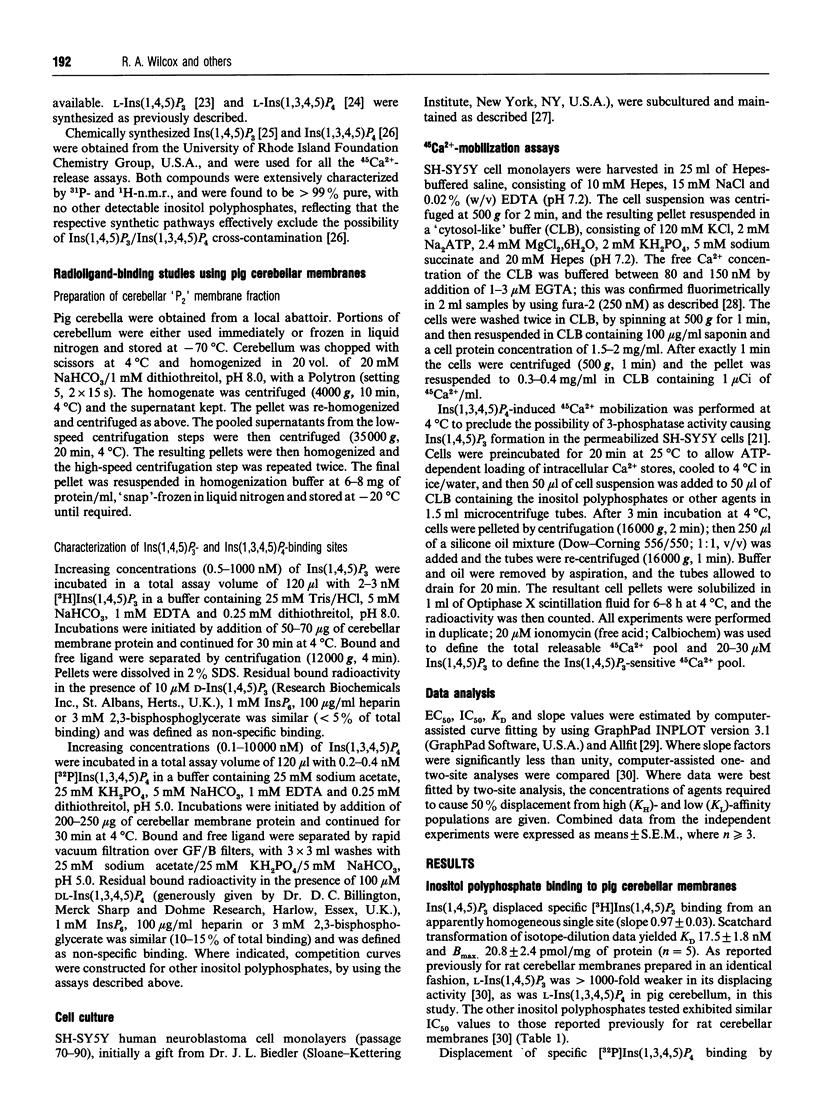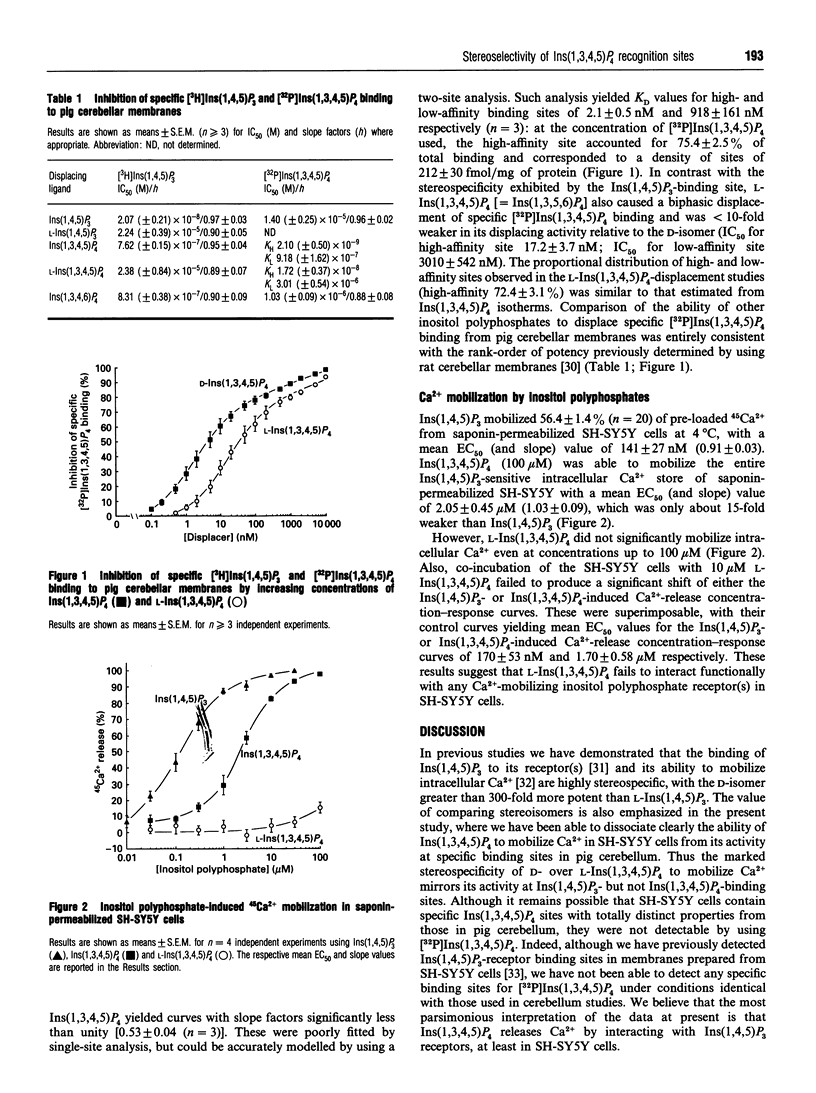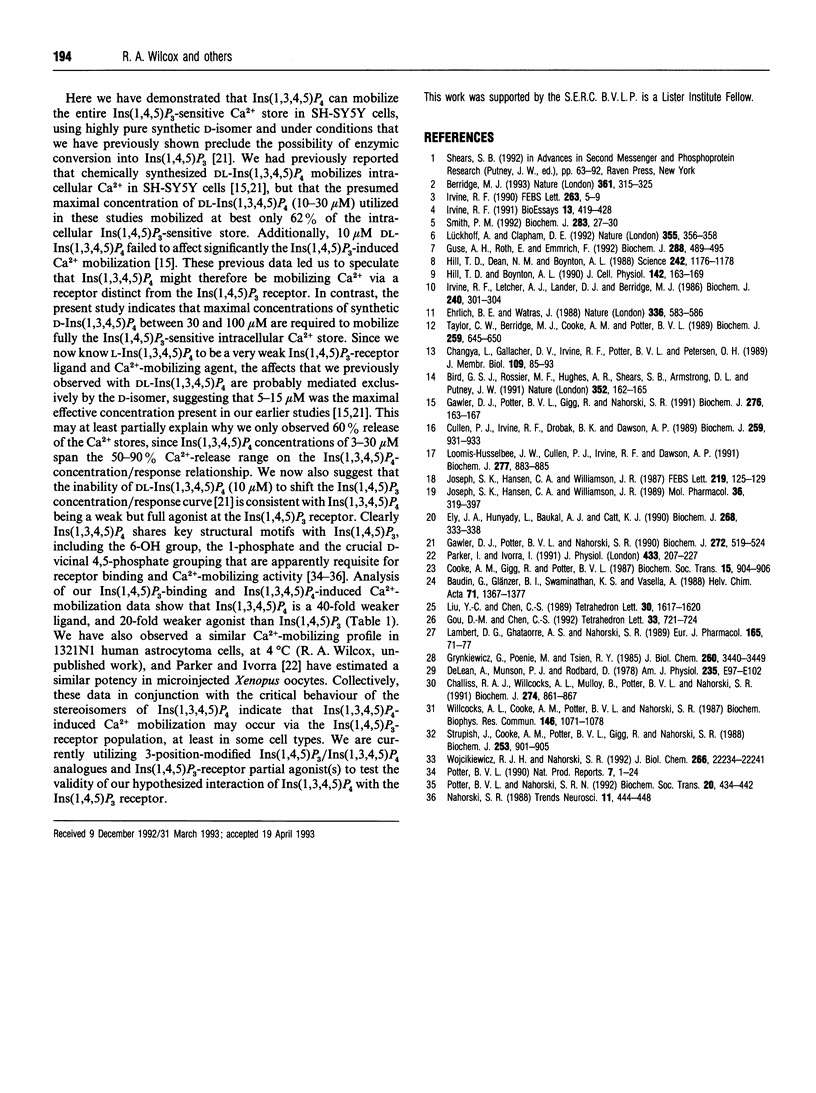Abstract
Ins(1,3,4,5)P4 was able to mobilize the entire Ins(1,4,5)P3-sensitive intracellular Ca2+ store in saponin-permeabilized SH-SY5Y human neuroblastoma cells in a concentration-dependent manner, yielding an EC50 value of 2.05 +/- 0.45 microM, compared with 0.14 +/- 0.03 microM for Ins(1,4,5)P3. However, L-Ins(1,3,4,5)P4 [= D-Ins(1,3,5,6)P4] failed to cause mobilization of intracellular Ca2+ at concentrations up to 100 microM. Binding studies using pig cerebellar membranes as a source of both Ins(1,4,5)P3/Ins(1,3,4,5)P4-specific binding sites have revealed a marked contrast in their stereospecificity requirements. Ins(1,4,5)P3-receptors from pig cerebella exhibited stringent stereospecificity, L-Ins(1,4,5)P3 and L-Ins(1,3,4,5)P4 were > 1000-fold weaker, whereas Ins(1,3,4,5)P4 (IC50 762 +/- 15 nM) was only about 40-fold weaker than D-Ins(1,4,5)P3 (IC50 20.7 +/- 9.7 nM) at displacing specific [3H]Ins(1,4,5)P3 binding from an apparently homogeneous Ins(1,4,5)P3 receptor population. In contrast, the Ins(1,3,4,5)P4-binding site exhibited poor stereoselectivity. Ins(1,3,4,5)P4 produced a biphasic displacement of specific [32P]Ins(1,3,4,5)P4 binding, with two-site analysis revealing KD values for high- and low-affinity sites of 2.1 +/- 0.5 nM and 918 +/- 161 nM respectively. L-Ins(1,3,4,5)P4 also produced a biphasic displacement of specific [32P]Ins(1,3,4,5)P4 binding which was less than 10-fold weaker than with D-Ins(1,3,4,5)P4 (IC50 values for the high- and low-affinity sites of 17.2 +/- 3.7 nM and 3010 +/- 542 nM respectively). Therefore, although L-Ins(1,3,4,5)P4 appears to be a high-affinity Ins(1,3,4,5)P4-binding-site ligand in pig cerebellum, it is a very weak agonist at the Ca(2+)-mobilizing receptors of permeabilized SH-SY5Y cells. We suggest that the ability of D-Ins(1,3,4,5)P4 to access intracellular Ca2+ stores may derive from specific interaction with the Ins(1,4,5)P3- and not the Ins(1,3,4,5)P4-receptor population.
Full text
PDF



Selected References
These references are in PubMed. This may not be the complete list of references from this article.
- Berridge M. J. Inositol trisphosphate and calcium signalling. Nature. 1993 Jan 28;361(6410):315–325. doi: 10.1038/361315a0. [DOI] [PubMed] [Google Scholar]
- Bird G. S., Rossier M. F., Hughes A. R., Shears S. B., Armstrong D. L., Putney J. W., Jr Activation of Ca2+ entry into acinar cells by a non-phosphorylatable inositol trisphosphate. Nature. 1991 Jul 11;352(6331):162–165. doi: 10.1038/352162a0. [DOI] [PubMed] [Google Scholar]
- Challiss R. A., Willcocks A. L., Mulloy B., Potter B. V., Nahorski S. R. Characterization of inositol 1,4,5-trisphosphate- and inositol 1,3,4,5-tetrakisphosphate-binding sites in rat cerebellum. Biochem J. 1991 Mar 15;274(Pt 3):861–867. doi: 10.1042/bj2740861. [DOI] [PMC free article] [PubMed] [Google Scholar]
- Changya L., Gallacher D. V., Irvine R. F., Potter B. V., Petersen O. H. Inositol 1,3,4,5-tetrakisphosphate is essential for sustained activation of the Ca2+-dependent K+ current in single internally perfused mouse lacrimal acinar cells. J Membr Biol. 1989 Jul;109(1):85–93. doi: 10.1007/BF01870793. [DOI] [PubMed] [Google Scholar]
- Cullen P. J., Irvine R. F., Drøbak B. K., Dawson A. P. Inositol 1,3,4,5-tetrakisphosphate causes release of Ca2+ from permeabilized mouse lymphoma L1210 cells by its conversion into inositol 1,4,5-trisphosphate. Biochem J. 1989 May 1;259(3):931–933. doi: 10.1042/bj2590931. [DOI] [PMC free article] [PubMed] [Google Scholar]
- DeLean A., Munson P. J., Rodbard D. Simultaneous analysis of families of sigmoidal curves: application to bioassay, radioligand assay, and physiological dose-response curves. Am J Physiol. 1978 Aug;235(2):E97–102. doi: 10.1152/ajpendo.1978.235.2.E97. [DOI] [PubMed] [Google Scholar]
- Ehrlich B. E., Watras J. Inositol 1,4,5-trisphosphate activates a channel from smooth muscle sarcoplasmic reticulum. Nature. 1988 Dec 8;336(6199):583–586. doi: 10.1038/336583a0. [DOI] [PubMed] [Google Scholar]
- Ely J. A., Hunyady L., Baukal A. J., Catt K. J. Inositol 1,3,4,5-tetrakisphosphate stimulates calcium release from bovine adrenal microsomes by a mechanism independent of the inositol 1,4,5-trisphosphate receptor. Biochem J. 1990 Jun 1;268(2):333–338. doi: 10.1042/bj2680333. [DOI] [PMC free article] [PubMed] [Google Scholar]
- Gawler D. J., Potter B. V., Gigg R., Nahorski S. R. Interactions between inositol tris- and tetrakis-phosphates. Effects on intracellular Ca2+ mobilization in SH-SY5Y cells. Biochem J. 1991 May 15;276(Pt 1):163–167. doi: 10.1042/bj2760163. [DOI] [PMC free article] [PubMed] [Google Scholar]
- Gawler D. J., Potter B. V., Nahorski S. R. Inositol 1,3,4,5-tetrakisphosphate-induced release of intracellular Ca2+ in SH-SY5Y neuroblastoma cells. Biochem J. 1990 Dec 1;272(2):519–524. doi: 10.1042/bj2720519. [DOI] [PMC free article] [PubMed] [Google Scholar]
- Grynkiewicz G., Poenie M., Tsien R. Y. A new generation of Ca2+ indicators with greatly improved fluorescence properties. J Biol Chem. 1985 Mar 25;260(6):3440–3450. [PubMed] [Google Scholar]
- Guse A. H., Roth E., Emmrich F. D-myo-inositol 1,3,4,5-tetrakisphosphate releases Ca2+ from crude microsomes and enriched vesicular plasma membranes, but not from intracellular stores of permeabilized T-lymphocytes and monocytes. Biochem J. 1992 Dec 1;288(Pt 2):489–495. doi: 10.1042/bj2880489. [DOI] [PMC free article] [PubMed] [Google Scholar]
- Hill T. D., Boynton A. L. Inositol tetrakisphosphate-induced sequestration of Ca2+ replenishes an intracellular pool sensitive to inositol trisphosphate. J Cell Physiol. 1990 Jan;142(1):163–169. doi: 10.1002/jcp.1041420120. [DOI] [PubMed] [Google Scholar]
- Hill T. D., Dean N. M., Boynton A. L. Inositol 1,3,4,5-tetrakisphosphate induces Ca2+ sequestration in rat liver cells. Science. 1988 Nov 25;242(4882):1176–1178. doi: 10.1126/science.2847317. [DOI] [PubMed] [Google Scholar]
- Irvine R. F. 'Quantal' Ca2+ release and the control of Ca2+ entry by inositol phosphates--a possible mechanism. FEBS Lett. 1990 Apr 9;263(1):5–9. doi: 10.1016/0014-5793(90)80692-c. [DOI] [PubMed] [Google Scholar]
- Irvine R. F. Inositol tetrakisphosphate as a second messenger: confusions, contradictions, and a potential resolution. Bioessays. 1991 Aug;13(8):419–427. doi: 10.1002/bies.950130810. [DOI] [PubMed] [Google Scholar]
- Irvine R. F., Letcher A. J., Lander D. J., Berridge M. J. Specificity of inositol phosphate-stimulated Ca2+ mobilization from Swiss-mouse 3T3 cells. Biochem J. 1986 Nov 15;240(1):301–304. doi: 10.1042/bj2400301. [DOI] [PMC free article] [PubMed] [Google Scholar]
- Joseph S. K., Hansen C. A., Williamson J. R. Inositol 1,3,4,5-tetrakisphosphate increases the duration of the inositol 1,4,5-trisphosphate-mediated Ca2+ transient. FEBS Lett. 1987 Jul 13;219(1):125–129. doi: 10.1016/0014-5793(87)81203-6. [DOI] [PubMed] [Google Scholar]
- Lambert D. G., Ghataorre A. S., Nahorski S. R. Muscarinic receptor binding characteristics of a human neuroblastoma SK-N-SH and its clones SH-SY5Y and SH-EP1. Eur J Pharmacol. 1989 Jun 8;165(1):71–77. doi: 10.1016/0014-2999(89)90771-1. [DOI] [PubMed] [Google Scholar]
- Loomis-Husselbee J. W., Cullen P. J., Irvine R. F., Dawson A. P. Electroporation can cause artefacts due to solubilization of cations from the electrode plates. Aluminum ions enhance conversion of inositol 1,3,4,5-tetrakisphosphate into inositol 1,4,5-trisphosphate in electroporated L1210 cells. Biochem J. 1991 Aug 1;277(Pt 3):883–885. doi: 10.1042/bj2770883. [DOI] [PMC free article] [PubMed] [Google Scholar]
- Lückhoff A., Clapham D. E. Inositol 1,3,4,5-tetrakisphosphate activates an endothelial Ca(2+)-permeable channel. Nature. 1992 Jan 23;355(6358):356–358. doi: 10.1038/355356a0. [DOI] [PubMed] [Google Scholar]
- Nahorski S. R. Inositol polyphosphates and neuronal calcium homeostasis. Trends Neurosci. 1988 Oct;11(10):444–448. doi: 10.1016/0166-2236(88)90196-8. [DOI] [PubMed] [Google Scholar]
- Parker I., Ivorra I. Inositol tetrakisphosphate liberates stored Ca2+ in Xenopus oocytes and facilitates responses to inositol trisphosphate. J Physiol. 1991 Feb;433:207–227. doi: 10.1113/jphysiol.1991.sp018422. [DOI] [PMC free article] [PubMed] [Google Scholar]
- Potter B. V., Nahorski S. R. Synthesis and biology of inositol polyphosphate analogues. Biochem Soc Trans. 1992 May;20(2):434–442. doi: 10.1042/bst0200434. [DOI] [PubMed] [Google Scholar]
- Potter B. V. Recent advances in the chemistry and biochemistry of inositol phosphates of biological interest. Nat Prod Rep. 1990 Feb;7(1):1–24. doi: 10.1039/np9900700001. [DOI] [PubMed] [Google Scholar]
- Shears S. B. Metabolism of inositol phosphates. Adv Second Messenger Phosphoprotein Res. 1992;26:63–92. [PubMed] [Google Scholar]
- Smith P. M. Ins(1,3,4,5)P4 promotes sustained activation of the Ca(2+(-dependent Cl- current in isolated mouse lacrimal cells. Biochem J. 1992 Apr 1;283(Pt 1):27–30. doi: 10.1042/bj2830027. [DOI] [PMC free article] [PubMed] [Google Scholar]
- Strupish J., Cooke A. M., Potter B. V., Gigg R., Nahorski S. R. Stereospecific mobilization of intracellular Ca2+ by inositol 1,4,5-triphosphate. Comparison with inositol 1,4,5-trisphosphorothioate and inositol 1,3,4-trisphosphate. Biochem J. 1988 Aug 1;253(3):901–905. doi: 10.1042/bj2530901. [DOI] [PMC free article] [PubMed] [Google Scholar]
- Taylor C. W., Berridge M. J., Cooke A. M., Potter B. V. Inositol 1,4,5-trisphosphorothioate, a stable analogue of inositol trisphosphate which mobilizes intracellular calcium. Biochem J. 1989 May 1;259(3):645–650. doi: 10.1042/bj2590645. [DOI] [PMC free article] [PubMed] [Google Scholar]
- Willcocks A. L., Cooke A. M., Potter B. V., Nahorski S. R. Stereospecific recognition sites for [3H]inositol(1,4,5)-triphosphate in particulate preparations of rat cerebellum. Biochem Biophys Res Commun. 1987 Aug 14;146(3):1071–1078. doi: 10.1016/0006-291x(87)90756-x. [DOI] [PubMed] [Google Scholar]
- Wojcikiewicz R. J., Nahorski S. R. Chronic muscarinic stimulation of SH-SY5Y neuroblastoma cells suppresses inositol 1,4,5-trisphosphate action. Parallel inhibition of inositol 1,4,5-trisphosphate-induced Ca2+ mobilization and inositol 1,4,5-trisphosphate binding. J Biol Chem. 1991 Nov 25;266(33):22234–22241. [PubMed] [Google Scholar]


